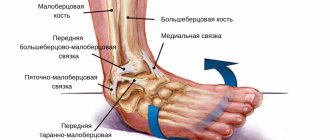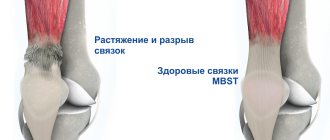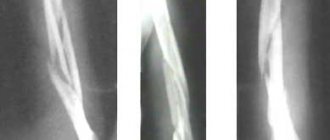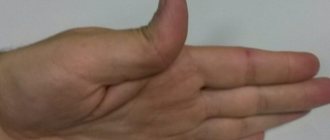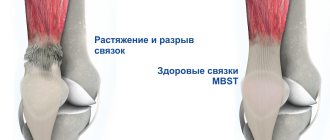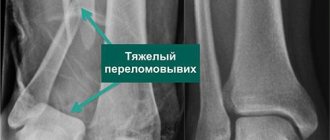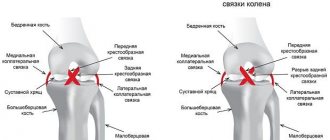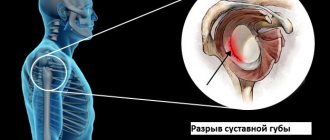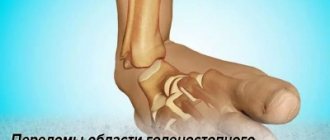Contracture of the ankle joint is a typical complication of long-term musculoskeletal diseases without appropriate treatment. This could be arthritis, arthrosis, ligament rupture, diastasis of the tibia and fibula, etc. This pathology provokes joint stiffness, which invariably affects gait and the ability to move independently for a long time. With a pronounced degree of stiffness, the foot is fixed in one position and the patient experiences difficulty walking, and even more so running.
In this material we will analyze the main reasons for the development of contracture of the ankle joint, the clinical symptoms of this pathology and methods of treating it without the use of surgery. The main methods of rehabilitation are considered, which allow you to restore the mobility of the foot and return freedom of movement to the patient.
Ankle contracture often develops after repeated soft tissue trauma. This may be a sprain or rupture of ligaments, muscle damage, divergence of the heads of the tibia and fibula when the integrity of the cartilage that connects them is violated. Stiffness develops gradually. There is a reduction in the length of ligaments, tendons and muscles. Therefore, it is very difficult to notice pathological changes at the initial stage. But if they appear, you should immediately seek medical help. Only an experienced doctor can correctly understand the potential causes of the disease. He will eliminate the possibility of one reason or another, give individual recommendations on choosing suitable shoes, organizing your work process, etc. Then an individual rehabilitation course will be developed. It will restore mobility in the ankle and eliminate the risk of progression of this disease in the future.
In Moscow, you can make an appointment for a free appointment with an orthopedist at our manual therapy clinic. Call the phone number indicated on the page and agree on a convenient time to visit the doctor. You can also fill out the registration form located below on the page. The administrator will contact you and agree on an appointment time.
Reasons for the development of ankle contracture
There are various reasons for the development of ankle contracture. The most common at a young age is the traumatic nature of the disease. In this case, the person leads an active, mobile lifestyle and plays sports. A traumatic effect on the ligamentous and tendon apparatus is invariably provoked. It undergoes regular stretching. Then, scar deformities form in places of microscopic ruptures. They reduce joint mobility and promote stiffness.
In old age, ankle contracture most often occurs against the background of osteoporosis, which provokes the destruction of bone tissue. After an ankle fracture or tibial fracture, it becomes necessary to immobilize the foot for a long period of time. The joint capsule contracts, the amount of synovial fluid in it decreases. Against the background of senile degenerative changes in the body, ankylosis of the joint may begin to form. This will lead to a decrease in the amplitude of his mobility in the future.
Other potential causes of ankle contracture include:
- desmogenic changes of an inflammatory and degenerative nature in the ankle area (ligaments, tendons, subcutaneous fatty tissue, etc. are damaged);
- infectious damage to the subcutaneous tissue, for example, erysipelas;
- deep burns and other sclerotic and cicatricial deformations of the skin, which significantly reduce the range of mobility of the foot;
- muscle atrophy and dystrophy, including those arising due to prolonged immobilization of the lower limb;
- disruption of the process of tissue innervation (may be a consequence of lumbosacral osteochondrosis with radicular syndrome, intervertebral disc herniation, plexitis, cauda equina syndrome, pinched nerve at the bifurcation point in the popliteal fossa, etc.);
- insufficiency of blood supply with the development of varicose veins of the lower extremities, atherosclerosis, diabetic angiopathy, etc.
If there are potential causes, there is a high probability of developing pathological changes in the tissues, against the background of which a violation of the mobility of the ankle joint occurs. Risk factors are also important:
- excess body weight, which creates an increased risk of injury at home and at work;
- maintaining a sedentary lifestyle, in which the muscles of the lower extremities lose their efficiency and tone, necessary to support all joints during movements;
- incorrect choice of shoes for sports and everyday wear;
- incorrect placement of the foot (flat feet or club feet), due to which there is an uneven distribution of shock-absorbing load on the tissues of the foot;
- degenerative diseases of large joints of the lower extremities;
- heavy physical labor associated with prolonged standing.
All these risk factors should be gradually eliminated from your daily life. In this way, it is possible to effectively prevent injuries and the development of contracture of the ankle joint.
Prevention
Medicine does not yet have power over the processes of intrauterine development of the unborn child, therefore specific methods for the prevention of congenital contracture have not been developed. But the risk of contracture of the wrist joint can be significantly reduced if a woman’s pregnancy takes place under proper conditions.
Measures to prevent the acquired form of pathology are:
- avoiding situations fraught with injury to the ankle joint, and if they cannot be avoided, using personal protective equipment;
- in case of injury - competent immobilization, correct implementation of rehabilitation measures;
- taking vitamins and mineral complexes;
- prevention, diagnosis and relief of disorders against which the described disease may occur.
Types of Ankle Contracture
Ankle contracture is divided into different types. First of all, classification is carried out due to the development of pathology:
- post-traumatic occurs after a bruise, crack, fracture, dislocation, rupture of ligaments;
- postoperative can develop as a complication after restoration of the integrity of the ankle ligaments;
- necrotic – occurs after tissue damage by aseptic or infectious necrosis;
- osteoporotic – is a consequence of the destruction of bone tissue;
- degenerative dystrophic - a companion to osteoarthritis or heel spurs.
Also in the classification of backlight, it matters in what plane the limitation of mobility is observed. Equinus contracture of the ankle joints most often occurs in early childhood. It is formed in babies at a time when they are just getting on their feet and starting to take their first steps. At the same time, they try to walk on their toes. For this reason, this type of contracture is called ballerina syndrome.
Flexion contracture of the ankle joint often develops due to degenerative dystrophic damage to the cartilage tissue of the ankle joint. When the cartilaginous shells are destroyed, bone tissue begins to deteriorate, and rough osteophytes - bone spines - form on the articular surfaces, which injure the surrounding tissues. As a result, a gradual decrease in the amplitude of joint mobility is observed.
Mixed contracture of the ankle joint is characterized by the fact that mobility is limited simultaneously in several planes. The patient cannot independently bend and straighten the foot, or make lateral and circular movements. This type of lesion is considered the most difficult and requires a long period of full rehabilitation.
Ankylosis
From a clinical point of view, ankylosis is divided into bone, or true, in which complete immobility of the joint is explained by bone fusion of the articular ends, and fibrous, or false, when the articular ends are fused together by fibrous, scar formations.
In the clinic, several differential signs are identified that make it possible to determine the nature of ankylosis. Firstly, with bone ankylosis, the immobilized joint is painless even with functional load; with fibrous ankylosis, increased functional load causes pain in the affected joint.
Secondly, the inflammatory process that caused bone ankylosis usually does not worsen in an immobilized joint; while fibrous ankylosis, which was a consequence of the same inflammatory arthritis, does not guarantee the patient against exacerbations of the inflammatory process.
Finally, corrective operations performed for bone ankylosis to correct the vicious position of the limb give lasting results - in contrast to fibrous ankylosis, in which the same corrective operations usually end in a relapse of the deformity.
X-ray examination allows us to definitively determine the nature of ankylosis.
There are ankyloses in the position of flexion, extension, adduction, abduction, external or internal rotation, supination, pronation. Combined forms of ankylosis are more common.
According to its functional significance, a limb can be fixed by ankylosis in a functionally advantageous or disadvantageous position. A functionally convenient installation is understood as a position of a limb that, in the absence of mobility in the joint, provides it with maximum performance. A functionally convenient position for the shoulder joint is abduction to an angle of 70°, elbow - flexion at an angle of 90°, wrist - dorsiflexion at an angle of 15°, hip - flexion 25-35° and abduction 8-10°, knee - flexion 5-10 °, ankle joint - plantar flexion 5°.
For some professions, functionally convenient joint positions generally accepted for ankylosis may be unfavorable, which must be taken into account when determining the patient’s ability to work.
Post-traumatic contracture of the ankle joint
Contracture of the ankle joint after a fracture of the ankle, tibia or fibula can form as a result of prolonged immobilization of the limb. Incorrectly applied plaster cast, lack of basic therapeutic exercises, complications - this is not a complete list of reasons why post-traumatic contracture of the ankle joint is formed.
The first step towards restoring joint mobility is to see an orthopedist. This specialist must conduct a full diagnosis, during which the potential cause of stiffness is determined.
If this is ankylosis of the joint due to effusion of fibrin into the joint capsule or penetration of blood, then before starting rehabilitation it is necessary to conduct a course of resorption therapy. This is best done through massage, reflexology and physiotherapy.
If the contracture has formed against the background of muscle fiber dystrophy or a reduction in the length of the ligamentous and tendon apparatus, then treatment can begin with therapeutic exercises and kinesiotherapy in combination with osteopathy.
Post-traumatic contracture of the ankle joint has a number of features:
- formed during the period of immobilization of the lower limb;
- differs in that the amplitude of mobility decreases in all projections and planes simultaneously;
- without modern treatment, it gradually progresses, leading to complete immobility of the joint;
- may cause a sudden change in gait;
- in advanced cases, it causes flat feet or club feet.
An orthopedist treats post-traumatic contracture of the ankle joint. During rehabilitation measures, it is recommended to exclude heavy physical activity on the lower extremities. Some experts recommend wearing special orthopedic shoes. But you should not give in to such recommendations. This can only make the existing problem worse.
A competent doctor will conduct a rehabilitation course without orthopedic shoes and completely restore the mobility of the ankle joint.
Treatment of ankle contracture
To treat ankle contracture, you need to go to specialized clinics. The rehabilitation is carried out by an orthopedist. This doctor diagnoses the patient’s condition and develops an individual recovery course depending on which muscles, ligaments and tendons have suffered the most.
Self-treatment is not recommended. There is a high probability of injury to tissues that have undergone degeneration and dystrophy. Treatment of ankle contracture will be successful if you first ensure that full blood supply to all tissues around the joint is restored. Osteopathy can be used for this - it allows you to improve the process of microcirculation of blood and lymphatic fluid in the lesion. Physiotherapy methods can also speed up the metabolic process in places where the integrity of soft and bone tissues is damaged.
Physical therapy plays a special role in the treatment of ankle contracture, since it helps restore the elasticity of all tissues: ligaments, tendons, muscles. It tones blood vessels and accelerates blood flow, improves the condition of muscle fiber, etc. It is best to combine sessions of therapeutic exercises or kinesiotherapy with massage or osteopathy. It is also recommended to use reflexology methods. Due to acupuncture, it has a beneficial effect on biologically active points on the human body. This starts the process of regeneration of damaged tissues and improves the general condition of the patient.
Laser treatment of joints in the formation of contracture is practiced. This effect ensures restoration of mobility. It launches natural tissue regeneration processes.
If you are developing ankle contracture and need quick and safe treatment, you can book a free appointment with our manual therapy clinic right now. Experienced doctors work here. They will conduct a full examination, make an accurate diagnosis and talk about the prospects and possibilities for rehabilitation in your individual case.
